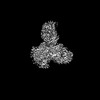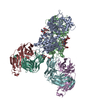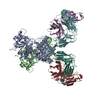[English] 日本語
 Yorodumi
Yorodumi- PDB-8tga: Complex of NPR1 ectodomain and REGN5381 Fab in an active-like sta... -
+ Open data
Open data
- Basic information
Basic information
| Entry | Database: PDB / ID: 8tga | ||||||
|---|---|---|---|---|---|---|---|
| Title | Complex of NPR1 ectodomain and REGN5381 Fab in an active-like state with no ANP bound | ||||||
 Components Components |
| ||||||
 Keywords Keywords | IMMUNE SYSTEM / Atrial natriuretic peptide / antibody / activator / pulmonary hypertension | ||||||
| Function / homology |  Function and homology information Function and homology informationANPR-A receptor complex / natriuretic peptide receptor activity / positive regulation of cGMP-mediated signaling / body fluid secretion / receptor guanylyl cyclase signaling pathway / peptide receptor activity / positive regulation of renal sodium excretion / guanylate cyclase / cGMP biosynthetic process / guanylate cyclase activity ...ANPR-A receptor complex / natriuretic peptide receptor activity / positive regulation of cGMP-mediated signaling / body fluid secretion / receptor guanylyl cyclase signaling pathway / peptide receptor activity / positive regulation of renal sodium excretion / guanylate cyclase / cGMP biosynthetic process / guanylate cyclase activity / Physiological factors / regulation of vascular permeability / positive regulation of urine volume / G protein-coupled peptide receptor activity / cGMP-mediated signaling / dopamine metabolic process / hormone binding / peptide hormone binding / negative regulation of angiogenesis / blood vessel diameter maintenance / negative regulation of smooth muscle cell proliferation / negative regulation of cell growth / regulation of blood pressure / cell surface receptor signaling pathway / receptor complex / protein kinase activity / GTP binding / ATP binding / plasma membrane Similarity search - Function | ||||||
| Biological species |  Homo sapiens (human) Homo sapiens (human) | ||||||
| Method | ELECTRON MICROSCOPY / single particle reconstruction / cryo EM / Resolution: 3.65 Å | ||||||
 Authors Authors | Franklin, M.C. / Romero Hernandez, A. | ||||||
| Funding support | 1items
| ||||||
 Citation Citation |  Journal: Nature / Year: 2024 Journal: Nature / Year: 2024Title: Agonist antibody to guanylate cyclase receptor NPR1 regulates vascular tone. Authors: Michael E Dunn / Aaron Kithcart / Jee Hae Kim / Andre Jo-Hao Ho / Matthew C Franklin / Annabel Romero Hernandez / Jan de Hoon / Wouter Botermans / Jonathan Meyer / Ximei Jin / Dongqin Zhang ...Authors: Michael E Dunn / Aaron Kithcart / Jee Hae Kim / Andre Jo-Hao Ho / Matthew C Franklin / Annabel Romero Hernandez / Jan de Hoon / Wouter Botermans / Jonathan Meyer / Ximei Jin / Dongqin Zhang / Justin Torello / Daniel Jasewicz / Vishal Kamat / Elena Garnova / Nina Liu / Michael Rosconi / Hao Pan / Satyajit Karnik / Michael E Burczynski / Wenjun Zheng / Ashique Rafique / Jonas B Nielsen / Tanima De / Niek Verweij / Anita Pandit / Adam Locke / Naga Chalasani / Olle Melander / Tae-Hwi Schwantes-An / / Aris Baras / Luca A Lotta / Bret J Musser / Jason Mastaitis / Kishor B Devalaraja-Narashimha / Andrew J Rankin / Tammy Huang / Gary Herman / William Olson / Andrew J Murphy / George D Yancopoulos / Benjamin A Olenchock / Lori Morton /    Abstract: Heart failure is a leading cause of morbidity and mortality. Elevated intracardiac pressures and myocyte stretch in heart failure trigger the release of counter-regulatory natriuretic peptides, which ...Heart failure is a leading cause of morbidity and mortality. Elevated intracardiac pressures and myocyte stretch in heart failure trigger the release of counter-regulatory natriuretic peptides, which act through their receptor (NPR1) to affect vasodilation, diuresis and natriuresis, lowering venous pressures and relieving venous congestion. Recombinant natriuretic peptide infusions were developed to treat heart failure but have been limited by a short duration of effect. Here we report that in a human genetic analysis of over 700,000 individuals, lifelong exposure to coding variants of the NPR1 gene is associated with changes in blood pressure and risk of heart failure. We describe the development of REGN5381, an investigational monoclonal agonist antibody that targets the membrane-bound guanylate cyclase receptor NPR1. REGN5381, an allosteric agonist of NPR1, induces an active-like receptor conformation that results in haemodynamic effects preferentially on venous vasculature, including reductions in systolic blood pressure and venous pressure in animal models. In healthy human volunteers, REGN5381 produced the expected haemodynamic effects, reflecting reductions in venous pressures, without obvious changes in diuresis and natriuresis. These data support the development of REGN5381 for long-lasting and selective lowering of venous pressures that drive symptomatology in patients with heart failure. | ||||||
| History |
|
- Structure visualization
Structure visualization
| Structure viewer | Molecule:  Molmil Molmil Jmol/JSmol Jmol/JSmol |
|---|
- Downloads & links
Downloads & links
- Download
Download
| PDBx/mmCIF format |  8tga.cif.gz 8tga.cif.gz | 353.6 KB | Display |  PDBx/mmCIF format PDBx/mmCIF format |
|---|---|---|---|---|
| PDB format |  pdb8tga.ent.gz pdb8tga.ent.gz | 240.7 KB | Display |  PDB format PDB format |
| PDBx/mmJSON format |  8tga.json.gz 8tga.json.gz | Tree view |  PDBx/mmJSON format PDBx/mmJSON format | |
| Others |  Other downloads Other downloads |
-Validation report
| Summary document |  8tga_validation.pdf.gz 8tga_validation.pdf.gz | 1.6 MB | Display |  wwPDB validaton report wwPDB validaton report |
|---|---|---|---|---|
| Full document |  8tga_full_validation.pdf.gz 8tga_full_validation.pdf.gz | 1.6 MB | Display | |
| Data in XML |  8tga_validation.xml.gz 8tga_validation.xml.gz | 56 KB | Display | |
| Data in CIF |  8tga_validation.cif.gz 8tga_validation.cif.gz | 82.4 KB | Display | |
| Arichive directory |  https://data.pdbj.org/pub/pdb/validation_reports/tg/8tga https://data.pdbj.org/pub/pdb/validation_reports/tg/8tga ftp://data.pdbj.org/pub/pdb/validation_reports/tg/8tga ftp://data.pdbj.org/pub/pdb/validation_reports/tg/8tga | HTTPS FTP |
-Related structure data
| Related structure data |  41234MC  8tg9C M: map data used to model this data C: citing same article ( |
|---|---|
| Similar structure data | Similarity search - Function & homology  F&H Search F&H Search |
- Links
Links
- Assembly
Assembly
| Deposited unit | 
|
|---|---|
| 1 |
|
- Components
Components
| #1: Protein | Mass: 52263.723 Da / Num. of mol.: 2 / Fragment: ectodomain Source method: isolated from a genetically manipulated source Source: (gene. exp.)  Homo sapiens (human) / Gene: NPR1, ANPRA / Production host: Homo sapiens (human) / Gene: NPR1, ANPRA / Production host:  #2: Antibody | Mass: 23323.898 Da / Num. of mol.: 2 Source method: isolated from a genetically manipulated source Source: (gene. exp.)   #3: Antibody | Mass: 24818.770 Da / Num. of mol.: 2 Source method: isolated from a genetically manipulated source Source: (gene. exp.)   Has protein modification | Y | |
|---|
-Experimental details
-Experiment
| Experiment | Method: ELECTRON MICROSCOPY |
|---|---|
| EM experiment | Aggregation state: PARTICLE / 3D reconstruction method: single particle reconstruction |
- Sample preparation
Sample preparation
| Component | Name: Active-like complex of NPR1 ectodomain and REGN5381 Fab, with no ANP present Type: COMPLEX / Entity ID: all / Source: MULTIPLE SOURCES |
|---|---|
| Molecular weight | Experimental value: NO |
| Source (natural) | Organism:  Homo sapiens (human) Homo sapiens (human) |
| Source (recombinant) | Organism:  |
| Buffer solution | pH: 7.5 |
| Specimen | Conc.: 1.6 mg/ml / Embedding applied: NO / Shadowing applied: NO / Staining applied: NO / Vitrification applied: YES |
| Vitrification | Cryogen name: ETHANE |
- Electron microscopy imaging
Electron microscopy imaging
| Experimental equipment |  Model: Titan Krios / Image courtesy: FEI Company |
|---|---|
| Microscopy | Model: FEI TITAN KRIOS |
| Electron gun | Electron source:  FIELD EMISSION GUN / Accelerating voltage: 300 kV / Illumination mode: FLOOD BEAM FIELD EMISSION GUN / Accelerating voltage: 300 kV / Illumination mode: FLOOD BEAM |
| Electron lens | Mode: BRIGHT FIELD / Nominal defocus max: 2500 nm / Nominal defocus min: 1000 nm |
| Image recording | Electron dose: 41 e/Å2 / Film or detector model: GATAN K3 BIOQUANTUM (6k x 4k) |
- Processing
Processing
| EM software |
| ||||||||||||
|---|---|---|---|---|---|---|---|---|---|---|---|---|---|
| CTF correction | Type: PHASE FLIPPING AND AMPLITUDE CORRECTION | ||||||||||||
| Particle selection | Num. of particles selected: 1312179 | ||||||||||||
| Symmetry | Point symmetry: C1 (asymmetric) | ||||||||||||
| 3D reconstruction | Resolution: 3.65 Å / Resolution method: FSC 0.143 CUT-OFF / Num. of particles: 495330 / Symmetry type: POINT | ||||||||||||
| Refinement | Cross valid method: NONE |
 Movie
Movie Controller
Controller



 PDBj
PDBj







